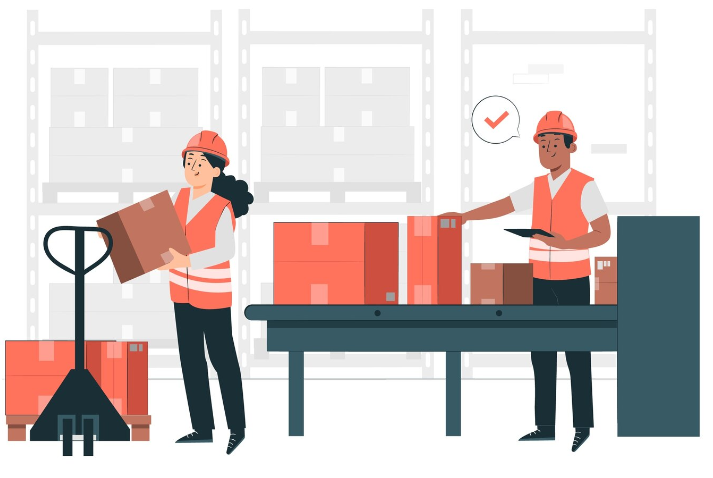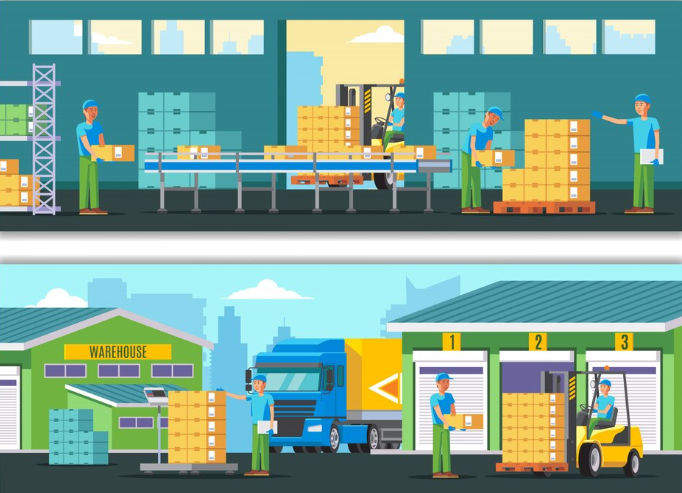Table of Contents
3PL vs In-house Logistics: Why You Should Consider Third-party Logistics
Time: Oct 10,2024 Author: SFC Source: www.sendfromchina.com
When it comes to managing fulfillment, e-commerce businesses are often faced with two options: third-party logistics (3PL) or in-house fulfillment. Which is the right choice for your business?In this detailed guide, we’ll compare the two strategies, helping you understand which option offers the best balance of cost, scalability, and efficiency as your business grows.

1. What Is Third-party Logistics(3PL)
Third-party logistics refers to outsourcing fulfillment, distribution, and warehousing operations to an external service provider. 3PL providers specialize in supply chain management, offering comprehensive solutions that handle the movement, storage, and delivery of products on behalf of businesses.3PL companies typically provide services such as:
Warehousing and storageInventory management
Picking & packing, and shipping orders
Transportation and freight forwarding
Returns management
Key Features of 3PL Providers
Scalability: 3PL providers have the capacity to scale operations as businesses grow, handling fluctuations in demand, seasonal peaks, and international expansion.Expertise: With years of experience in logistics, 3PL companies leverage their knowledge to optimize processes, reduce costs, and improve delivery times.
Technology Integration: Leading 3PL providers often incorporate advanced technology like warehouse management systems (WMS) and real-time inventory tracking to provide better visibility and control for e-commerce businesses.
Advantages of 3PL for E-commerce Businesses
Cost Efficiency: By leveraging existing infrastructure and negotiated shipping rates, 3PL providers help businesses save on fulfillment costs.Focus on Core Business: Outsourcing logistics allows e-commerce companies to focus on other critical aspects of the business, such as marketing, product development, and customer service.
Reduced Shipping Times: Many 3PL providers have multiple fulfillment centers, enabling faster deliveries by strategically storing inventory closer to end customers.
2. What Is In-house Fulfillment

Key Components of In-house Fulfillment
Warehouse Management: Companies manage their own warehouse or storage space, organizing products for easy access and efficient order processing.Inventory Control: Businesses maintain direct oversight of inventory levels, replenishing stock as needed and ensuring that products are available for timely order fulfillment.
Order Processing: Employees handle all aspects of the order process, including picking, packing, labeling, and shipping.
The In-house Fulfillment Process
Receiving Inventory: The company receives inventory from manufacturers or suppliers and stores it in-house.Order Management: When customers place orders, the in-house team picks the products from inventory.
Shipping: The team packs and ships the products to customers using selected carriers.
Advantages of In-house Fulfillment
Control: Companies have complete control over their fulfillment process, allowing them to customize packaging and delivery strategies.Branding: In-house fulfillment allows for more personalized branding opportunities, such as customized packaging or branded inserts.
Direct Oversight: In-house fulfillment provides direct visibility and management over inventory, making it easier to adapt to specific customer needs or changes in demand.
3. Why You Need In-house Fulfillment

3.1 Brand Control and Customization
Businesses that prioritize unique packaging, unboxing experiences, and consistent branding may prefer in-house fulfillment. By keeping fulfillment in-house, companies can ensure that packaging aligns with their brand identity and delivers a memorable experience for their customers.3.2 Direct Oversight of Inventory
In-house fulfillment offers businesses the ability to closely monitor their inventory, making real-time adjustments as needed. It is especially critical for companies that deal with limited-edition items, perishable goods, or products with fluctuating demand.3.3 Cost Efficiency for Small Volumes
For startups and small businesses with low order volumes, managing fulfillment in-house can be more cost-effective than outsourcing to a 3PL. There’s no need to pay for external services, and the business maintains control over all aspects of the process.3.4 Greater Flexibility
In-house fulfillment gives businesses greater flexibility to adapt to market changes, quickly adjusting packaging, order processing, and shipping strategies as needed.4. Why You Need Third-party Logistics

4.1 Scalability and Growth Support
3PL providers offer scalable solutions that can grow with your business. As e-commerce companies expand, 3PLs can handle increasing order volumes, international shipping, and complex supply chain operations without the need for the business to invest in additional infrastructure or staff.4.2 Cost Savings Through Expertise
With years of experience and industry relationships, 3PLs often secure better shipping rates and negotiate favorable terms with carriers. They also use established processes and advanced technology to reduce inefficiencies and keep fulfillment costs low.4.3 Access to Advanced Technology
Many 3PL providers offer technology platforms that integrate with e-commerce stores, providing real-time inventory tracking, automated order management, and streamlined shipping processes. The technological edge enables businesses to provide better customer service and stay competitive.4.4 Global Reach
For businesses with international customers, 3PL providers often have a network of distribution centers across the globe. This enables faster delivery times and reduces the challenges associated with cross-border logistics.5. 3PL vs In-house Fulfillment

5.1 Cost Comparison
Upfront Investment: In-house fulfillment requires significant initial investment in warehousing, staff, and technology. On the other hand, 3PLs reduce upfront costs by providing ready-made infrastructure.Ongoing Costs: While in-house fulfillment may offer cost savings at low volumes, as order volumes increase, 3PL providers typically offer more competitive pricing due to economies of scale.
5.2 Control Over Operations
In-house Fulfillment: Offers full control over every aspect of the fulfillment process, including inventory management, packaging, and shipping.3PL: By outsourcing, businesses relinquish some control but gain expertise and efficiency, as well as the ability to focus on core operations.
5.3 Scalability
3PL Providers: Designed for scalability, allowing businesses to quickly ramp up operations without worrying about infrastructure constraints.In-house Fulfillment: Scaling in-house fulfillment requires significant investment in additional warehouse space, staff, and technology.
5.4 Technology and Integration
In-house Fulfillment: Businesses must invest in their own warehouse management systems and technology for inventory tracking and order management.3PL Providers: Most 3PLs offer integrated technology platforms that sync with e-commerce stores, providing seamless order management and real-time tracking.
5.5 Customization and Branding
In-house Fulfillment: Offers more flexibility for branded packaging and personalized customer experiences.3PL Providers: While some 3PLs allow for branding, the level of customization may be more limited compared to in-house fulfillment.
6. Choosing Between 3PL and In-house Fulfillment: Key Considerations
When deciding between third-party logistics and in-house fulfillment, e-commerce businesses must evaluate several factors, including:Business Size and Order Volume: Small businesses with limited order volume may find in-house fulfillment more cost-effective. However, growing businesses often benefit from the scalability of 3PLs.
Control and Branding: Companies that prioritize branding and control over packaging might opt for in-house fulfillment, while those focusing on efficiency and cost savings may prefer 3PLs.
Budget: Consider the initial and ongoing costs of each model, factoring in long-term growth potential.
Technology Needs: Determine whether the business has the capacity to invest in technology for inventory management or if leveraging a 3PL's integrated platform would be more beneficial.
7. Common Myths About Third-party Logistics

3PL is only for large businesses
While many large enterprises use 3PL services, small and medium-sized businesses can also benefit from outsourcing their logistics operations to save time and reduce costs.Outsourcing means losing control
Many 3PL providers offer customizable solutions, allowing businesses to maintain control over critical aspects like branding, packaging, and delivery times.3PL is too expensive
While there are upfront costs to outsourcing, 3PL providers often help businesses save in the long run through optimized shipping rates and increased efficiency.3PLs don’t care about your brand
Reputable 3PLs understand the importance of maintaining a brand’s reputation and work closely with businesses to ensure that their standards are met.8. Get Started with SFC Services
SFC stands at the forefront of order fulfillment with cutting-edge facilities in Shenzhen, China. Utilizing sophisticated software, we specialize in seamless and trustworthy fulfillment solutions for ecommerce, dropshipping, and crowdfunding platforms. At SFC, we are dedicated to accelerating your business growth through secure warehousing, efficient processing, customizable packaging options, and adaptable shipping strategies while saving you time and money.Whether you have or do not have a fulfillment partner, particularly your products manufactured in China, you should consider SFC. Click the button below and get help from SFC logistics experts.
What Makes SFC Special
Over 17 Years of 3PL and Order Fulfillment ExperienceAll-in-one Tracking Number
Popular Platform API Integration
30 Days of Free Storage
No Hidden Fee
Custom Packaging
Worldwide shipping solutions
Value-added Services
9. FAQs
1. What is the main difference between 3PL and in-house fulfillment?
The key difference lies in control and infrastructure. In-house fulfillment allows businesses to manage their entire supply chain, while 3PL outsources logistics to an external provider, offering scalability and expertise.2. Is third-party logistics better for small businesses?
Small businesses with growing order volumes often benefit from outsourcing logistics to a 3PL provider, as it allows them to focus on core business activities and avoid heavy investment in warehousing and staff.3. Can I still customize my packaging with a 3PL provider?
Yes, many 3PL providers offer customization options for packaging. However, the level of customization may vary depending on the provider and the services offered.4. How do I know when it’s time to switch to a 3PL provider?
If your business is experiencing rapid growth, facing operational inefficiencies, or struggling to manage increasing order volumes, it may be time to consider outsourcing to a 3PL provider.5. Are there any downsides to using third-party logistics?
While 3PL offers many benefits, businesses may face challenges such as reduced control over operations, potential communication gaps, and dependency on external providers. Post Views:3717
Post Views:3717
Copyright statement: The copyright of this article belongs to the original author. Please indicate the source for reprinting.
Previous Post
Top 10 Warehouse Management Challenges and Solutions
Next Post
TAGS
Hot Research
Get a Custom China Fulfillment Solution with FREE Storage for 30 Days
 Want to know about our services, fees or receive a custom quote?
Want to know about our services, fees or receive a custom quote?
 Please fill out the form on the right and we will get back to you within a business day.
Please fill out the form on the right and we will get back to you within a business day.
 The more information you provide, the better our initial response
will be.
The more information you provide, the better our initial response
will be.






 TAGS:
TAGS: